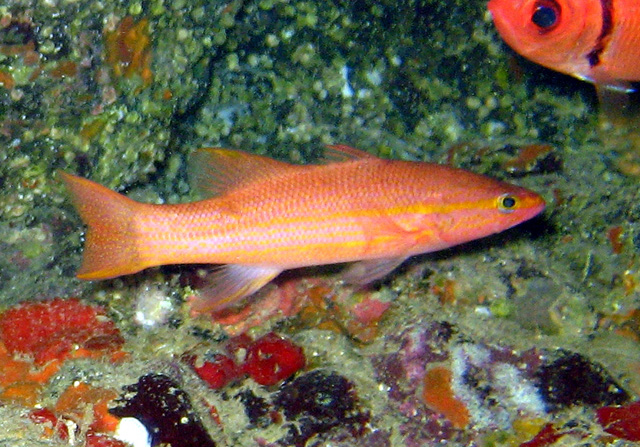| Liopropomatidae (Painted basslets), subfamily: Liopropomatinae |
| 12.35 cm SL (male/unsexed); 10.18 cm SL (female) |
|
reef-associated; marine; depth range 20 - 32 m |
| Eastern Atlantic, Cape Verde Islands. |
|
Dorsal spines (total): 8-8; Dorsal soft rays (total): 11-11; Anal spines: 3-3; Anal soft rays: 8-8. This species is distinguished by the following characters: D VI?I?I+11; seventh dorsal spine embedded and scaled over, the first dorsal spine minute, both are only visible in the radiographs; sixth dorsal spine clearly visible above interdorsal ridge; 16 pectoral rays; about 54 lateral-line scales (only countable in holotype); approx. 4?5+1+8?11 gill rakers; inner teeth at front of jaws and side of lower jaw substantially longer than teeth in outer row; posterior margin of upper central part of preopercle is irregular, finely serrated; pink ground coloration, with broad yellow-orange stripe from snout through eye along the midlateral part of flanks; numerous thinner yellow-orange stripes above and below this central stripe, slightly irregular on opercle and tail; yellow-orange caudal fin's upper and lower margin, the dorsal margin of softray dorsal fin and lower margin of anal fin; caudal fin slightly emarginate (Ref. 91766). |
| Encountered in front of a vertical wall covered with the sun coral Tubastrea aurea, at 36 m depth. It retreated into one of the many small (bucket to bathtub-sized) caves in this wall. During later dives, several other individuals were encountered along the same vertical wall, but additional individuals were later also seen in other areas, consisting of large boulders overgrown with black coral (Antipathella and Tanacetipathes species.). They retreated below these boulders when approached. The most common species in the same area were the soldier fishes Myripristis jacobus Cuvier, 1829 and Sargocentron hastatum (Cuvier, 1829); and Corniger spinosus Agassiz, 1831, was also seen at the vertical Tubastrea wall (Ref. 91766). |
|
Not Evaluated (N.E.) Ref. (130435)
|
| harmless |
Source and more info: www.fishbase.org. For personal, classroom, and other internal use only. Not for publication.

